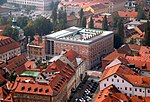Rooster Bridge
20th-century architecture in SloveniaArch bridges in SloveniaBridges completed in 1931Bridges in LjubljanaBridges over the Gradaščica ... and 3 more
Jože Plečnik buildingsPedestrian bridges in SloveniaTrnovo District

The Rooster Bridge (Slovene: Petelinji most, Petelinja brv, Petelinov most, Tenente) in Ljubljana, the capital of Slovenia, is a footbridge crossing the Gradaščica River in the Trnovo District south of the downtown of Ljubljana. It stands between the Trnovo Bridge and the outflow of the Gradaščica into the Ljubljanica,: 127 and connects Gradaščica Street (Gradaška ulica) in the northern Krakovo neighbourhood (left bank) to Eipper Street (Eipprova ulica) in the southern Trnovo neighbourhood (right bank). These are the oldest Ljubljana suburbs, known for their market gardens and cultural events.
Excerpt from the Wikipedia article Rooster Bridge (License: CC BY-SA 3.0, Authors, Images).Rooster Bridge
Petelinja brv, Ljubljana Trnovo
Geographical coordinates (GPS) Address Nearby Places Show on map
Geographical coordinates (GPS)
| Latitude | Longitude |
|---|---|
| N 46.043419444444 ° | E 14.503566666667 ° |
Address
Petelinja brv
1115 Ljubljana, Trnovo
Slovenia
Open on Google Maps









